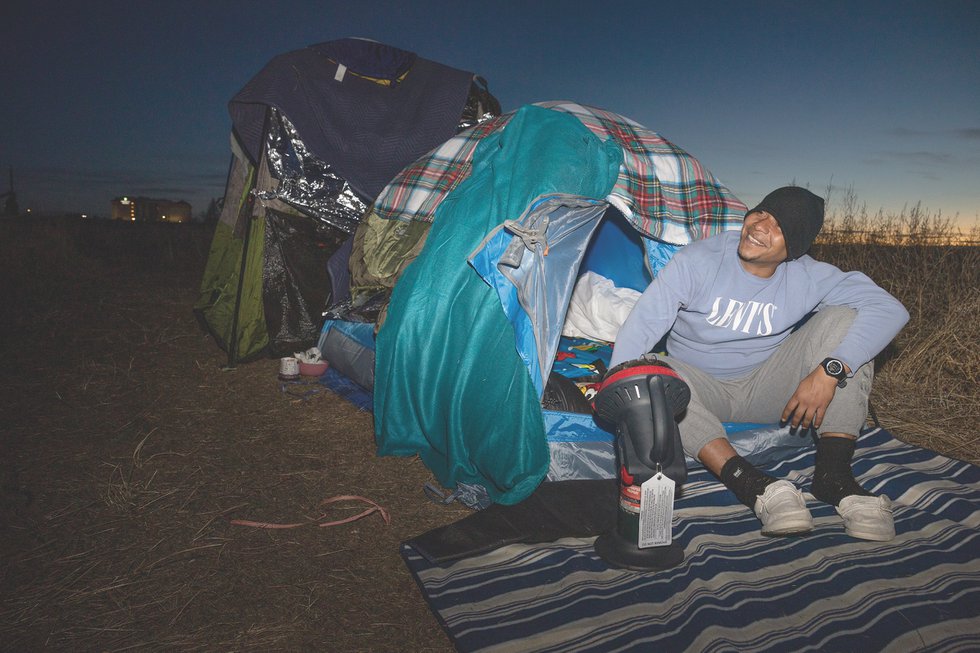Robert Davis reports that new immigrants in Denver are facing a steep climb towards stability, as services are not able to keep up with the demand.
According to Robert Davis, Denver’s fresh immigrants face a rough climb toward stability as services are insufficient in the face of unmet demand. According to Robert Davis, fresh immigrants in Denver face a steep climb to stability as services are lacking in the face of unmet demand.
Robert Davis reports that new immigrants in Denver are facing a steep climb towards stability, as services are not able to keep up with the demand.
Forty-two-year-old María Ángel and her family arrived in Denver, Colorado, just three months ago, after fleeing the brutal regime of Venezuelan dictator Nicolás Maduro. Part of the journey required María Ángel, who asked that her last name not be revealed, her husband, and her six-year-old son to walk across the roughly sixty-mile Darién Gap—a jungle between Colombia and Panama with steep mountains and vast swamps. María Ángel says her son became a warrior during the journey.. . After arriving in the United States, María Ángel says the family spent their first eight days in a Texas jail while they were processed by immigration officials. When they were released, she says they were told that Denver is a “beautiful city” where they would receive services. They were given bus tickets for the twelve-hour ride north. María Ángel says her family made it to Denver “by the grace of God” and that she and her husband are eager to begin working to build a new life for their son.. . But starting that new life has proven to be difficult. María Ángel says the family has not been able to access services that many Venezuelan migrants receive when they first arrive, such as work permits and welfare benefits, because they can’t afford a lawyer or the $545 federal application fee.. . For their first few months, the family stayed at a hotel on the outskirts of town that serves as a temporary shelter, but they were evicted in early March because of a city policy that limits their stay to forty-two days. The family was then placed in an apartment, but María Ángel worries about their stability going forward.. . “We don’t have money to pay rent or another place to go,” she says.. . ×. Expand. Giles Clasen. Emiliano plays soccer in the parking lot in front of a hotel the City of Denver is renting to house migrants. His mother asked that we not publish Emiliano’s last name out of fear that talking to the press could affect their asylum application.. She is one of more than 38,000 immigrants (or “newcomers,” as Mayor Mike Johnston, a Democrat, calls them) who have arrived in Denver from Central and South America over the past fourteen months. Not only have the arrivals overwhelmed the local government, nonprofit service providers, and local infrastructure, but they have also exposed a rift within the community regarding who is worthy of receiving social services.. . Many of the immigrants arriving in Denver were sent there by Greg Abbott, the Republican governor of Texas, following the end of Title 42, a law that had allowed federal officials to deny immigrants access to the United States on public health grounds. Abbott told The Texas Tribune in May 2023 that he was sending migrants to Democrat-run cities like Denver, New York City, and Philadelphia, as a political ploy to get President Joe Biden to “step up and fulfill [his] Constitutional duty to secure the border.” Those words ring hollow now, after Republicans in early February blocked—at the behest of former President Donald Trump—a bipartisan immigration reform bill that would have strengthened border security.. . This is happening at a time when Denver and other cities that have welcomed thousands of immigrants, like Chicago and New York, are trying to balance their response to the twin crises of increased immigration and soaring homelessness. And the two issues are becoming increasingly intertwined.. . . The normal immigration process requires people to connect with a local temporary resettlement agency, such as the International Rescue Committee or the African Community Center in Denver, to receive housing, social benefits, and work permits. But this system has been overwhelmed in the last three years as the agencies battle swelling caseloads resulting from the COVID-19 pandemic and a growing need for their services.. . For its part, the City of Denver has tried to step in and fill the gaps. Its human services department put out a call for immigration attorneys and volunteers to help tackle the backlog of applicant screenings for work permits. The city has also created so-called tiger teams that work across agencies to address the immigration crisis. So far, it has spent more than $51 million to date to provide services to new immigrants, and Johnston has estimated it could cost around $180 million to provide services for migrants by the end of the year. Johnston cut funding from Parks and Recreation and the Department of Motor Vehicles to secure some of the funds for migrant services, a move that The Denver Post editorial board decried as “imprudent.”. . Johnston has largely laid blame for Denver’s immigration crisis at the feet of federal lawmakers. During an appearance on Washington Post Live in mid-February, Johnston chastised Trump for spearheading the efforts to block the bipartisan immigration bill that could have helped Denver address the issue by providing more funding for border security and asylum interviewers. He has also appeared on Fox News to tell federal lawmakers that the immigration crisis has almost pushed the city to its “breaking point.”. . ×. Expand. Giles Clasen. From left, Louis, Daniel, Elias Aponte, Arturo Gerder, Richar Rodríguez, and Carmen Mujica sit near a propane fire to keep warm in a migrant encampment near downtown Denver. Louis and Daniel asked that their last names not be used due to safety concerns.. Johnston acknowledged during a February 26 press conference that the city’s response to the immigration crisis is “unsustainable” and that the city is working to reduce the total number of services it provides to new immigrants. “This does not minimize the importance of that need,” Johnston said. “Our job is to be responsive, to be thoughtful, to be humane, to be efficient in our delivery of services. We will continue to do that.”. . Two days later, Johnston said those plans included closing four shelters to save the city approximately $60 million.. . The scale of need is simply too large for the city to manage, and it could soon create political problems for Denver’s first-term mayor. Johnston campaigned on a promise to “end homelessness” in Denver within his first term, and launched a program called House1000 to achieve it. The program provided temporary housing for 1,100 of Denver’s more than 5,800 unhoused people in 2023 at a cost of about $45 million, and Johnston plans to replicate those results in 2024.. . . But the issues of homelessness and migration have increasingly overlapped as encampments of immigrants have cropped up, especially in predominantly Latinx neighborhoods on the north and west sides of the city. To make money, many of the immigrants work odd jobs or wash car windows at traffic lights. Then there are those like Jesús Rafael Abreu, otherwise known as “Yupi the Clown,” who performs magic tricks and juggling acts to survive.. . Andy Conejos, who migrated to Denver from Venezuela, told the city council in February that he and many of his peers are eager to work. But the slow work permit process is forcing them to make a lot of tough choices. Conejos said many migrants simply don’t have the $6,000 to $8,000 that immigration lawyers charge to help someone through the process of obtaining a Social Security number and work permit. They’re also harassed by the police and have been issued multiple $100 “warning tickets” for “aggressive panhandling,” he said.. . “Folks in this situation are refugees, but they’re having to stay in tents or live on the streets, not because they want to, but because of a lack of resources. And now is the time to do something about it,” Conejos said with the help of a translator.. . ×. Expand. Giles Clasen. Migrants eat a meal brought to their camp by volunteers in Denver.. Denver seems to be alone in addressing the issue in the state. Metro area cities like Aurora and Lakewood have declared themselves “nonsanctuary cities” in an effort to dissuade migrants from coming to their doorstep. More rural communities, like Colorado Springs, Grand Junction, and Monument, have also adopted the moniker.. . The arrivals also seem to have sundered metro communities like Lakewood, where some residents have shown up in droves since January at city council meetings to voice opposition to city leaders partnering with Denver to address the issue, Colorado Public Radio (CPR) reported.. . One Lakewood resident told CPR that she had “watched Denver’s decline, and [didn’t] want the same here.” Another said she drove about ninety minutes from Summit County to try to prevent the issue from spreading there. Lakewood’s mayor said the city has not committed to spending any money to address increased immigration.. . For both María Ángel and Conejos, these debates come at a steep cost. Both told The Progressive that the one thing they need is a job, but they’re stuck until the city’s service providers can catch up.. . Says María Ángel: “I’m terrified of what will happen if we have to live on the streets.”











